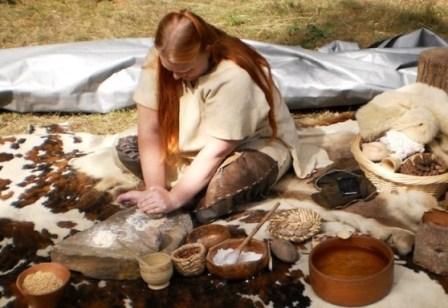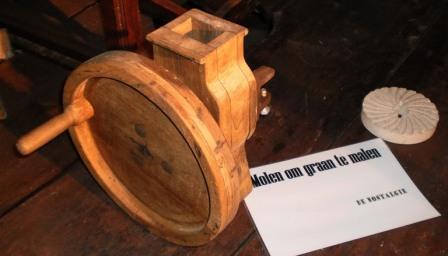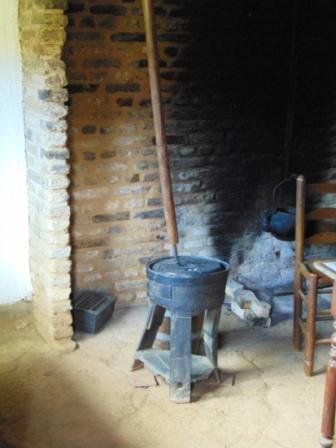 Grains are the dried seeds of improved grasses: wheat, rye and barley, as well as rice and corn.
Grains are the dried seeds of improved grasses: wheat, rye and barley, as well as rice and corn.
Chaff is inedible casing where the grain is packed in during growth on the ear.
The bran is the sheet that is around the grain. It is composed of fused layers fiber fabric. For rice the bran is called the pericarp.
The English word for “flour” comes originally from “flower “meaning the finest (part of the meal) by elimination of coarse and bran.
Flour is to powder ground cereal such as wheat, with germ (the core), endosperm and bran (the outer layer) in it. Also called wholemeal four (or 100% whole-wheat).
White flour consists only of the germ and the light part of the kernel (close to the germ). The heavy portion (close to the bran) of the kernel (= meal), and the bran are ’sifted’ through a rotating sieve machine. White flour is sifted flour.
Gluten are corn- protein, necessary to let rise dough with yeast and give it elasticity. They keep the gas that is produced by yeast. The amount of gluten per type of grain varies widely. Wheat contains many and rye little gluten.
Grain milling
 Grain is crushed between two stones. Formerly with manpower, later with wind and water mills.
Grain is crushed between two stones. Formerly with manpower, later with wind and water mills.
In the round millstones are grooves, the furrows and feathering. The grain is deposited in an opening in the middle of the upper stone. It is ground between stones and runs down through the side by a flour gutter pipe.
When meal or flour with water is kneaded to a dough, it creates a complex protein: gluten.
The dough is used for bread and pasta.
Dough for bread consists of flour and water with yeast or leaven, and usually salt is added. Different flours and other additives (nuts, egg, milk,...) provide variation.
The quern is a hand grain mill that was already used by the Celts. The upper, round stone has a hole in the middle and a handle at the outer edge to rotate him.
An even older form is a runner (upper, round grind) without hole that was rubbed back and forth or twisted over a lying flat stone.
Before there were flat stones (saddle stone) with a rubbing stone, and improved mortars.
This daily boring toil was mostly women's work.
Historical names
Grains, seeds or herbs can be crushed with a blow stone, hammer or pestle in a mortar or on an anvil. To grind, a rubbing stone, flour stone grinder or pressure was rubbed over the quern, millstone, saddle stone, grind or metate.
It is often believed that in ancient Egypt for the first time around 17,000BC bread was baked. But in Cuddie Falls, New South Wales, Australia, fragments are found of ancient millstones that Aboriginals used to make flour from grass seeds 30 to 40,000 years ago.
 At the founding of Rome the gang of Romulus managed to rob 683 Sabine virgins during a bout with drunken made Sabines. The Sabines declared them then the war, but were calmed by the new Sabine spouses of the Romans. It was then agreed that the Roman women did not have to grind grain. For this boring work they had a (chained) prisoner slave, the pistor.
At the founding of Rome the gang of Romulus managed to rob 683 Sabine virgins during a bout with drunken made Sabines. The Sabines declared them then the war, but were calmed by the new Sabine spouses of the Romans. It was then agreed that the Roman women did not have to grind grain. For this boring work they had a (chained) prisoner slave, the pistor.
Primarily spelt has been used. To get white flour and dough pellets were polished: rubbed with lime or sand until they were white, and then sieved and washed before use. (In cheaper bread sometimes there was still sand.)
Cooked porridge of spelt delivers the oldest and most famous Roman dish: pulse. This was not baked, but soaked and kneaded with cheese, honey and egg.
Legumes (beans and others) and rice were also milled to flour for bread.
The Greek Hecateus wrote in the 6th century BC that the Celts realized by use of winter and summer corn two harvests per year (Spelt? And barley?). The Celts also built the first grain harvesters: a wooden box with two drawbars to be pushed forward through the grain by donkey or ox. At the level of the bottom of the spikes, there was a comb. Which tore off the spikes. There are also stone bas-reliefs showing another method. Behind the container was set a slave to cut off the spikes of corn above the comb with a sickle. (The Romans copied it from the Treveri as their vallus. It was re-'invented' back in the 19th century in Australia: as.. The Stripper). The fields were approximately 0,4ha large. This could be plowed by two oxen in two days at about 3km / h). This wealth was one of the main reasons for Caesar to invade the region, then known as the breadbasket of Europe.
If you ate pasta and antipasto, would you still be hungry? (George Carlin)
The food here is terrible, and the portions are too small. (Woody Allen)
